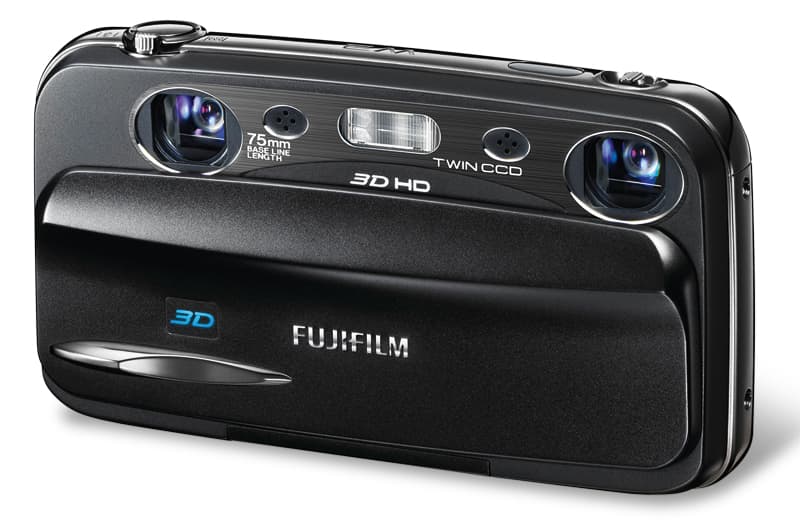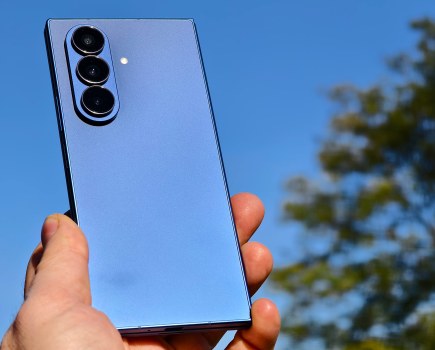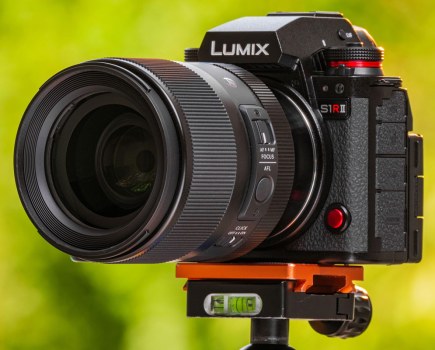FinePix Real 3D W3 At a glance
- Compact camera
- Dual 10-million-pixel sensors
- 35-105mm lenses
- 3D or 2D still capture
- 720p 3D/2D video
- Street price £350
Fujifilm FinePix Real 3D W3 introduction
Fujifilm was very quick off the mark with its first 3D compact camera, the W1, and managed to hit the shelves just as the latest 3D craze flooded the cinemas and the home-entertainment market.
So while both Sony and Panasonic have now produced 3D functionality within their latest models, Fujifilm has now produced a second, more refined 3D camera.
This new model, the W3, is slimmer than the first, with an improved lenticular LCD screen and HD video capture in 3D or 2D. The starting price of the camera is also £100 cheaper than the W1 on release, making it even more appealing for the 3D fan.
Features

Image: A low-light street scene taken in 3D (2D shown here) gives a real sense of depth to the image
To offer a real 3D experience, the W3 uses dual lenses, placed 64mm apart, to simulate the distance between our eyes. These images are captured on two separate 1/2.3in, 10MP CCD sensors and the 3D HD RP (real photo) processor then combines this information to produce MPO-type 3D still images or a 3D AVI file.
The W3 can also be used as a standard 2D compact camera and, even when in 3D mode, it will also record by default a JPEG image alongside the 3D file. Still images are output at a standard 10MP size of 3648×2736 pixels for both 2D and 3D images, with 4:3 and 16:9 options also available, and at 1080×720 pixels for video.
The lenses offer a 35mm equivalent of 35-105mm focal length with a maximum aperture of f/3.7-4.2. This gives a decent range for standard scenes and portraits – the wideangle abilities are limited by the use of the dual lenses. Similarly, close focus is just 38cm in 3D mode but 8cm in 2D. The ISO offers a range of 100-1600 with three auto settings to limit it to either ISO 400, 800, or 1600. Metering offers a choice of average, spot and multi, with ±2EV exposure compensation.
There is a choice of fully manual, aperture priority and program shooting modes, along with full auto, two sets of scene modes and advanced 2D and 3D settings.
The advanced 2D settings allow you to use each lens to provide two alternate shots at once; this includes a wideangle and telephoto combination, a choice of two colour settings and two ISO sensitivities.
The advanced 3D modes allow you to move the camera between the two shots being taken, to allow you to widen the distance. This increases the perceived 3D effect for distant subjects or allows you to get closer for macro shots. This can be done with a timed interval between the shots or by pressing the shutter twice.
When shooting in 3D, the autofocus will, by default, automatically set the parallax control of the two lenses to determine the extent of the 3D effect. This can also be fine-tuned with a rocker on the top of the camera.
The rear LCD screen on the W3 is lenticular in its design, which means it will display an apparent 3D image without the need for any special glasses. Compared to the screen on the W1, this new 3.5in display is larger and the viewing angle has been improved, making it easier to see the 3D effect..
Build and handling
 The W3 is noticeably slimmer than the previous W1, making it far more pocket-friendly, although it is still on the large side for a compact camera.
The W3 is noticeably slimmer than the previous W1, making it far more pocket-friendly, although it is still on the large side for a compact camera.
The lens cover alone, which slides down to reveal the dual lenses and flash, adds significant bulk; the camera would perhaps be better served with individual thin lens covers.
It is also fairly heavy at 230g, despite again being lighter than the previous model. On the rear of the camera, however, the space has been well used, with most of it filled by the gigantic LCD screen.
The mode dial and D-pad controls to its right are very usable and allow easy control of the camera. The menu system is much in keeping with that of other Fujifilm compacts – much more so than the W1 – making it easier to navigate.
One slight annoyance with the W3 is, that, because of the second lens, many users will need to adjust the regular grip they would take with a compact in order to keep fingers clear of the lenses. This is perhaps unavoidable but it can result in some stray digits in shot before you get used to it.
Performance
Using the W3 is a far more enjoyable experience than the W1 – mainly due to the ease with which it focuses and the ability to see the results clearly on the LCD screen. The auto parallax control has been drastically improved and it seldom needed adjusting via the top rocker control. This means you can almost ignore the parallax and focus as you would on a standard 2D compact camera.
Metering is well controlled and gives a nice even exposure under most conditions. But like many compacts, under high-contrast scenes the metering can overexpose the highlights to maintain the general exposure.
 Image: Taken at the maximum ISO 1600, the image is still fairly noise-free but lacks fine detail on close inspection
Image: Taken at the maximum ISO 1600, the image is still fairly noise-free but lacks fine detail on close inspection
It is easy to forget that this camera works proficiently as a regular 2D compact when you don’t need its 3D capabilities, and in doing so this opens up further features such as face detection, multipoint AF and high-speed continuous shooting. The degree of manual control available is impressive from a compact, although menu use is needed to access it. Unfortunately, it lacks any lens or sensor-based stabilisation, although I appreciate this would be difficult to facilitate, due to the dual lenses and dual sensors.
The camera also takes an exceptionally long time to start up, with around seven seconds from sliding the lens cover down to being able to shoot.
Most importantly, though, the 3D pictures from the W3 look stunning, with a crisp and clear image that has such a remarkable depth to the scene you could almost walk into it. Seeing them on the back of the camera is impressive enough, but once they are viewed on a large monitor or 3D TV the effect is even more dramatic.
On close inspection of the JPEG files there are artefacts visible in the images even at ISO 100. This appears to be a result of noise reduction and gives a slight watercolour feel to the images, causing a lack of fine detail. This only starts to become pronounced at ISO 800 and above, and even then the images remain well coloured and still very usable. On our resolution chart the camera only reached a total of 14 at ISO 100 and just 10 at ISO 1600. Effects are less noticeable on the 3D files, partly as the effect is more of a distraction.
Resolution, noise & dynamic range

These images show 72ppi sections of images of a resolution chart, captured with the lens set to its 100mm point. We show the section of the resolution chart where the camera starts to fail to reproduce the lines separately. The higher the number visible in these images, the better the camera’s detail resolution is at the specified sensitivity setting.
Our verdict
If you’re looking to achieve 3D photos, the W3 is the ideal solution. It produces high-quality 3D images with the least effort while leaving you the option to fine-tune and tweak both the 3D effect and the exposure.
For everyday use, however, it does lack some standard compact features, crucially stabilisation, and the body is still a little on the large size despite being a great improvement on the W1.
Image and video quality are slightly questionable in 2D, but for 3D use on TV displays the flaws are not obvious and the camera can achieve great-looking results, even at the higher ISO ratings. This camera is an affordable way into 3D imagery and a must for any 3D fan.







